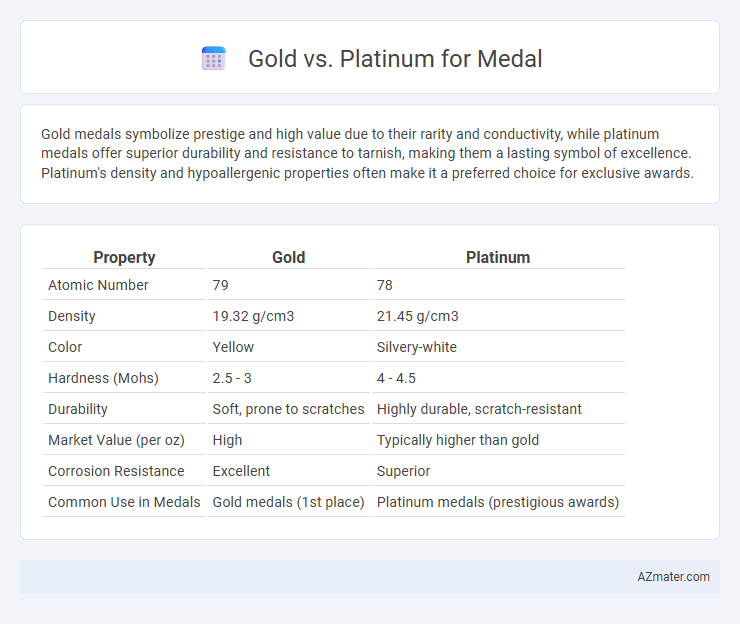Gold medals symbolize prestige and high value due to their rarity and conductivity, while platinum medals offer superior durability and resistance to tarnish, making them a lasting symbol of excellence. Platinum's density and hypoallergenic properties often make it a preferred choice for exclusive awards.
Table of Comparison
| Property | Gold | Platinum |
|---|---|---|
| Atomic Number | 79 | 78 |
| Density | 19.32 g/cm3 | 21.45 g/cm3 |
| Color | Yellow | Silvery-white |
| Hardness (Mohs) | 2.5 - 3 | 4 - 4.5 |
| Durability | Soft, prone to scratches | Highly durable, scratch-resistant |
| Market Value (per oz) | High | Typically higher than gold |
| Corrosion Resistance | Excellent | Superior |
| Common Use in Medals | Gold medals (1st place) | Platinum medals (prestigious awards) |
Introduction: Gold vs Platinum Medals
Gold medals symbolize highest achievement and are traditionally awarded for first place in competitions worldwide. Platinum medals, rarer and more expensive, have recently been introduced in some events to signify extraordinary accomplishments beyond gold standards. The choice between gold and platinum medals highlights differences in prestige, material value, and cultural significance in recognizing excellence.
Historical Significance of Gold and Platinum Medals
Gold medals have historically symbolized first-place achievement and unparalleled excellence in competitions such as the Olympic Games since 1904, embodying prestige and timeless value. Platinum medals, introduced more recently in select events, convey rarity and exclusivity but lack the deep-rooted cultural significance that gold holds. The prominence of gold as a symbol of victory is reinforced by its long-standing association with wealth, durability, and universal recognition across civilizations.
Physical Properties: Gold vs Platinum
Gold exhibits a density of approximately 19.32 g/cm3 and is highly malleable with a Mohs hardness of 2.5 to 3, making it easy to shape but prone to scratches. Platinum has a higher density of around 21.45 g/cm3 and a greater hardness rating of 4 to 4.5 on the Mohs scale, providing superior durability and resistance to wear. Both metals resist tarnishing, but platinum's physical robustness ensures medals maintain their luster and structural integrity longer than gold.
Prestige and Symbolism in Awards
Gold medals symbolize unparalleled achievement and timeless prestige, historically associated with supreme victory and high honor in competitive events worldwide. Platinum medals, though rarer and often more expensive, convey exclusivity and innovation, representing exceptional distinction in elite or specialized awards. Both metals serve as powerful symbols of excellence, with gold emphasizing traditional honor and platinum highlighting rarity and modern prestige.
Rarity and Value Comparison
Platinum is significantly rarer than gold, contributing to its higher value despite gold's historic status as a precious metal. The density and durability of platinum make it more resistant to wear, ideal for medals meant to last generations. Market fluctuations often see gold's value surpass platinum temporarily, but long-term rarity and industrial demand keep platinum prized in elite awards.
Durability and Longevity
Platinum medals offer superior durability and longevity compared to gold medals due to platinum's higher resistance to tarnishing and corrosion. Gold is softer and more prone to scratching, making platinum an ideal choice for awards that require lasting prestige and preservation over time. The inherent hardness of platinum ensures medals maintain their shine and structural integrity even under frequent handling or environmental exposure.
Global Recognition and Preference
Gold medals hold the highest global recognition and symbolize supreme achievement in sports, arts, and academic competitions worldwide. Platinum medals, while prestigious, are less commonly awarded and often reserved for special categories or limited editions, making gold the preferred choice for top honors. The strong historic and cultural association of gold with victory ensures its dominant preference across international events and organizations.
Manufacturing and Cost Factors
Gold medals, typically plated with 24-karat gold over a silver base, require precise electroplating techniques that drive up manufacturing costs due to gold's high material value and scarcity. Platinum medals demand more complex manufacturing processes, including high-temperature melting and alloying, which increase production time and expenses, as platinum's density and melting point are significantly higher than gold's. Cost factors favor gold medals for mass production, while platinum medals incur premium charges reflecting their rarity, durability, and intensive fabrication requirements.
Environmental Impact of Gold and Platinum Mining
Gold mining consumes significantly more energy and water compared to platinum mining, resulting in higher greenhouse gas emissions and extensive habitat disruption. Platinum extraction, although less prevalent, often involves lower environmental degradation due to more efficient mining processes and smaller quantities needed for applications like medals. Choosing platinum over gold for medals reduces the overall ecological footprint by minimizing resource depletion, toxic waste production, and ecosystem disturbance during the metal extraction phase.
Conclusion: Choosing the Best Medal Material
Gold medals symbolize prestige and tradition, offering high value and a classic appearance, while platinum medals provide unmatched durability and a modern, sleek aesthetic. Selecting the best medal material depends on priorities such as budget, symbolic significance, and longevity. For events seeking timeless honor and widespread recognition, gold remains the preferred choice, whereas platinum suits those valuing strength and exclusivity.

Infographic: Gold vs Platinum for Medal
 azmater.com
azmater.com